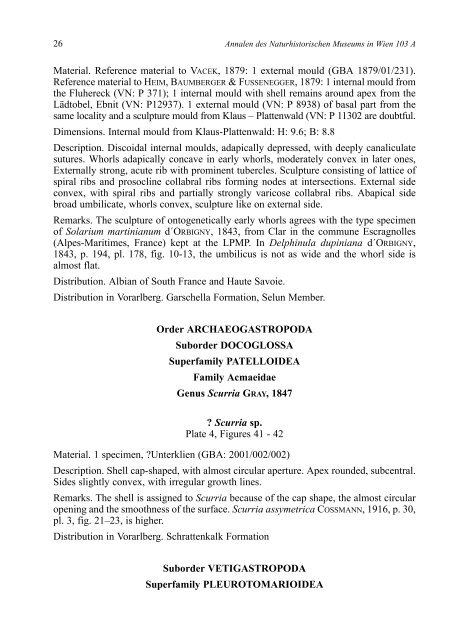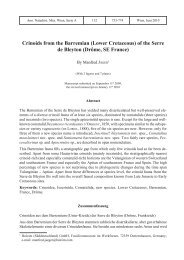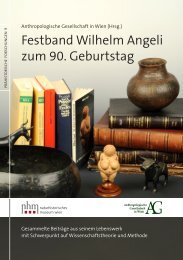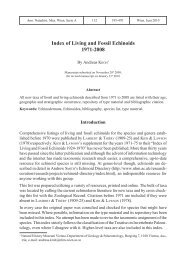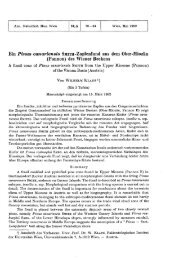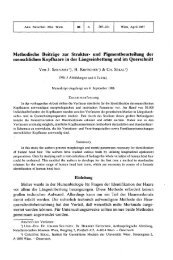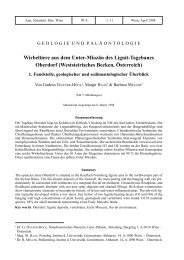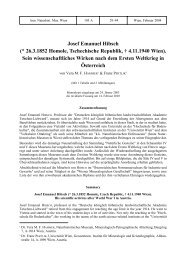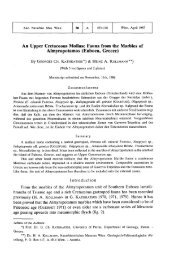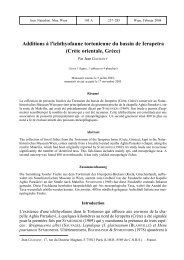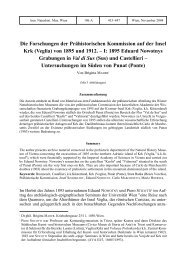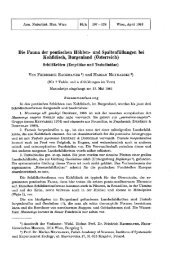Gastropods from the Lower Cretaceous of Vorarlberg, Austria. A ...
Gastropods from the Lower Cretaceous of Vorarlberg, Austria. A ...
Gastropods from the Lower Cretaceous of Vorarlberg, Austria. A ...
Create successful ePaper yourself
Turn your PDF publications into a flip-book with our unique Google optimized e-Paper software.
26 Annalen des Naturhistorischen Museums in Wien 103 A<br />
Material. Reference material to VACEK, 1879: 1 external mould (GBA 1879/01/231).<br />
Reference material to HEIM, BAUMBERGER & FUSSENEGGER, 1879: 1 internal mould <strong>from</strong><br />
<strong>the</strong> Fluhereck (VN: P 371); 1 internal mould with shell remains around apex <strong>from</strong> <strong>the</strong><br />
Lädtobel, Ebnit (VN: P12937). 1 external mould (VN: P 8938) <strong>of</strong> basal part <strong>from</strong> <strong>the</strong><br />
same locality and a sculpture mould <strong>from</strong> Klaus – Plattenwald (VN: P 11302 are doubtful.<br />
Dimensions. Internal mould <strong>from</strong> Klaus-Plattenwald: H: 9.6; B: 8.8<br />
Description. Discoidal internal moulds, adapically depressed, with deeply canaliculate<br />
sutures. Whorls adapically concave in early whorls, moderately convex in later ones,<br />
Externally strong, acute rib with prominent tubercles. Sculpture consisting <strong>of</strong> lattice <strong>of</strong><br />
spiral ribs and prosocline collabral ribs forming nodes at intersections. External side<br />
convex, with spiral ribs and partially strongly varicose collabral ribs. Abapical side<br />
broad umbilicate, whorls convex, sculpture like on external side.<br />
Remarks. The sculpture <strong>of</strong> ontogenetically early whorls agrees with <strong>the</strong> type specimen<br />
<strong>of</strong> Solarium martinianum d´ORBIGNY, 1843, <strong>from</strong> Clar in <strong>the</strong> commune Escragnolles<br />
(Alpes-Maritimes, France) kept at <strong>the</strong> LPMP. In Delphinula dupiniana d´ORBIGNY,<br />
1843, p. 194, pl. 178, fig. 10-13, <strong>the</strong> umbilicus is not as wide and <strong>the</strong> whorl side is<br />
almost flat.<br />
Distribution. Albian <strong>of</strong> South France and Haute Savoie.<br />
Distribution in <strong>Vorarlberg</strong>. Garschella Formation, Selun Member.<br />
Order ARCHAEOGASTROPODA<br />
Suborder DOCOGLOSSA<br />
Superfamily PATELLOIDEA<br />
Family Acmaeidae<br />
Genus Scurria GRAY, 1847<br />
? Scurria sp.<br />
Plate 4, Figures 41 - 42<br />
Material. 1 specimen, ?Unterklien (GBA: 2001/002/002)<br />
Description. Shell cap-shaped, with almost circular aperture. Apex rounded, subcentral.<br />
Sides slightly convex, with irregular growth lines.<br />
Remarks. The shell is assigned to Scurria because <strong>of</strong> <strong>the</strong> cap shape, <strong>the</strong> almost circular<br />
opening and <strong>the</strong> smoothness <strong>of</strong> <strong>the</strong> surface. Scurria assymetrica COSSMANN, 1916, p. 30,<br />
pl. 3, fig. 21–23, is higher.<br />
Distribution in <strong>Vorarlberg</strong>. Schrattenkalk Formation<br />
Suborder VETIGASTROPODA<br />
Superfamily PLEUROTOMARIOIDEA


